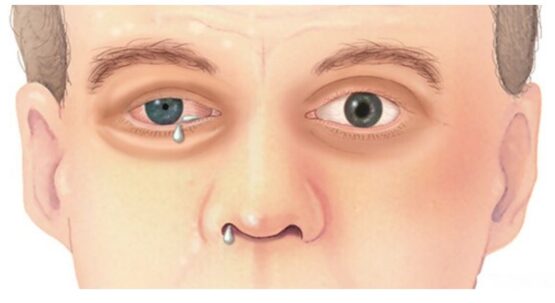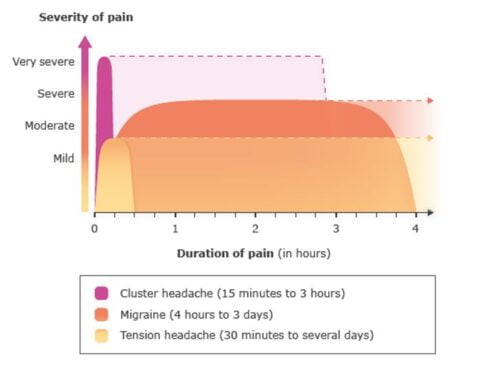With the progression of technological advancements, many of us are in front of our computer or cellphone screens for a bigger chunk of our time. This has significantly affected our sleep cycle thus reducing the optimum time for sleep. This factor, along with many others, has elevated the incidence as well as the frequency of headaches. In this article, let us focus on a headache that initiates from a particular location i.e. at the right side of the head, and its possible causes.

Headaches in different parts of the head region
Cluster headaches
Cluster headaches are the type of headaches that affect the right side of the brain. The pain starts, particularly affecting the right eye, and progresses towards the face, head, and neck region. These headaches usually occur every day at the same time and episodically last for 4 to 12 weeks followed by a remission period. Once the remission period is over, the headaches are back usually at the same time of the year when they first started. Men, as compared to women, are more prone to such types of headaches.

A cluster headache affecting the right eye resulting in tearing and discharge
Symptoms of cluster headaches
In case of a cluster headache, the patient may experience:
- Redness in the eye
- Sweating
- Discharge of water from the affected eye
- A shrunk pupil in the affected eye
- Runny or blocked nostrils
Causes of a cluster headache
If you are experiencing a headache, the following factors may be responsible for it:
- Lifestyle factors: Contributing factors of headaches related to lifestyle include:
- Fatigue
- Caffeine withdrawal
- Stress
- Frequently skipping meals
- Problems associated with the neck muscles
- Long-term use of over-the-counter analgesics
- Allergic reactions and infections: Sinus allergies as well as infections can also be responsible for the initiation of a headache that lasts longer.

Comparison of severity of pain among the cluster headache, migraine, and tension headache
- Overuse of certain medications: If any of the following medications is used consecutively for 10 to 15 days a month, it is likely to experience headaches:
- Panadol (Acetaminophen)
- Non-steroidal anti-inflammatory drugs (NSAIDs)
- Aspirin
- Caffeine
- Migraine-treating drugs such as triptans, ergotamines, and opioids
- Neurological problems: A cluster headache can also be the result of some neurological modifications happening in an individual’s brain. These include:
- Occipital neuralgia: It results due to damage in the occipital nerves and causes sharp pain in the brain. The eyes and neck are also affected. The individual becomes highly sensitive to light.
- Temporal arteritis: In temporal arteritis, the arteries of the head and neck region are inflamed resulting in severe pain in the head which progresses towards the facial muscles. The patient reports extreme fatigue and pain in the temples.
- Trigeminal neuralgia: In trigeminal neuralgia, the trigeminal nerve is damaged. The affected individual report severe pain in the facial muscles and the head region.
- Miscellaneous factors: Other causes of headaches include:
- Anxiety and mood disorders
- Genetic factors
- Obstructive sleep apnea i.e. inability to breathe during sleep
- Trauma
- Stroke
- Aneurysm
- Benign or malignant tumors
How to self-manage a headache?
To manage a headache at home, the following steps may be taken:
- Taking a warm shower may help with the alleviation of a headache.
- Taking a nap and avoiding distractions that are negatively affecting your sleep improves overall health and reduce headaches significantly.

Home remedies for the management of a headache
- Avoiding strong smells, loud noises, and bright lights for some time helps manage the headache.
- Dehydration can be a prominent cause of headaches. Therefore, drinking a lot of water often relieves the headache within a few hours.
- Lying down for a few minutes helps improve your posture and relaxes the neck muscles which proves to be effective in headache management. Moreover, a warm compress can also be used on the neck muscles.
The medical diagnosis of a cluster headache
For the diagnosis of cluster headaches, your physician might want to run some tests apart from the symptomatic evaluation of the conditions. These tests include:
- Blood tests
- CT-scan
- MRI
Treatment options
If the headache is not relieved by any of the above-mentioned practices, the following might help:
- Acupuncture
- Yoga
- Physical therapy
- Relaxation techniques
- Oxygen therapy
- Paracetamol
- Sumatriptan injection
- Sumatriptan or Zolmitriptan nasal sprays
How to prevent a cluster headache?
By taking some medications, there is a chance that a person can avoid the initiation of an episode of cluster headaches. Verapamil is a drug of choice when it comes to the prophylactic treatment of cluster headaches. However, due to the drug’s ability to affect heart muscles, it is recommended to use it with close monitoring of the patient’s heart via ECG. Additionally, the use of corticosteroids and other local anesthetics in the form of injections is also recommended. These injections are given into the occipital nerve present at the back of your head.
Conclusion
Headache is a common affliction these days as the factors causing these headaches have become quite common to experience. The individual affected by them has to endure the pain and discomfort for hours to several days. One such time of headache in the cluster headache which is restricted to the right side of the head, particularly the area around the eye. However, once diagnosed, cluster headaches are easy to manage and treat.

PhD Scholar (Pharmaceutics), MPhil (Pharmaceutics), Pharm D, B. Sc.
Uzma Zafar is a dedicated and highly motivated pharmaceutical professional currently pursuing her PhD in Pharmaceutics at the Punjab University College of Pharmacy, University of the Punjab. With a comprehensive academic and research background, Uzma has consistently excelled in her studies, securing first division throughout her educational journey.
Uzma’s passion for the pharmaceutical field is evident from her active engagement during her Doctor of Pharmacy (Pharm.D) program, where she not only mastered industrial techniques and clinical case studies but also delved into marketing strategies and management skills.
Throughout her career, Uzma has actively contributed to the pharmaceutical sciences, with specific research on suspension formulation and Hepatitis C risk factors and side effects. Additionally, Uzma has lent her expertise to review and fact-check articles for the Health Supply 770 blog, ensuring the accuracy and reliability of the information presented.
As she continues her PhD, expected to complete in 2025, Uzma is eager to contribute further to the field by combining her deep knowledge of pharmaceutics with real-world applications to meet global professional standards and challenges.








